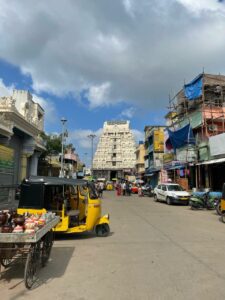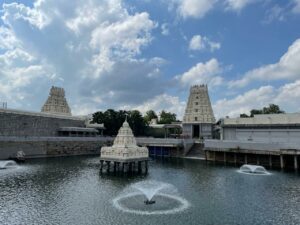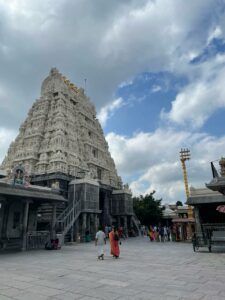Kanchi Kamakshi Amman Temple is one of the most sacred and ancient Hindu temples dedicated to Goddess Kamakshi.

King Thondaiman Ilandiraiyan of the Pallava dynasty, who ruled Kanchipuram, constructed the temple. (Rama Ramanan/South First)
India has three main cities where the Goddess Shakti is worshipped. Kanchipuram holds the most important rank among the three. In the same order, the three places are Kanchipuram where Kanchi Kamakshi Amman is revered. Madurai, where Goddess Meenakshi is worshipped, and Kashi, where the deity is Visalakshi.
Kanchi is sacred to Sakti Peeta. Here, Parasakti, having Saraswathi and Parvathi as her eyes, rules Kanchi as goddess Kamakshi. The Kanchi Kamakshi Amman temple was mentioned in Perunaraatrupadai, an ancient Tamil literature that praises the renowned Sangam era. King Thondaiman Ilandiraiyan of the Pallava dynasty, who ruled Kanchipuram, constructed the temple.
It is believed that Adi Sankaracharya, the 8th century Indian Vedic scholar, established the Sri Chakra in this shrine.

At the temple, Goddess Kamakshi is in a sitting posture resembling a lotus. (Rama Ramanan/South First)
According to legend, Goddess Kamakshi settled in this temple after destroying the demon Bhandasura, who was created from the ashes of Manmatha, the god of love. She performed a penance on a fire pit to please Lord Shiva, who appeared before her and married her.
It is believed that Kamakshi was originally a Ugra Swaroopini. Upon establishing the Sri Chakra, Adi Sankara personified her as the Shanta Swaroopini.
Legend has it that during the days of Adi Sankara, the presence of the Ugra Swaroopini was felt outside the temple precincts. Sankaracharya had requested her to not leave the temple complex. Symbolic of this, the festival image of Kamakshi takes leave from Sankaracharya, at his shrine in the inner prakaram, each time she is taken out for a procession.
Goddess Kamakshi is in a sitting posture resembling a lotus, and hence called the Padmasana. The goddess holds a sugarcane bow in her left arm and lotus and parrot in her right, in addition to Pasha-Ankusha.
A Chandra Prabhai (crescent shape of the moon) on the forehead is also present.
She is referred to as the Parabrahma Swaroopini, seated with the trinity of Brahm, Vishnu and Siva.
The Kamakshi temple covers an area of about 5 acres. The sanctum is crowned with a gold-plated vimanam. The complex is dotted with Sannadhis, Mandapas, the pushkarini(temple tank), all rich in architectural splendour and with intricate carvings.
The outer prakaram houses the temple tank, and several mandapams such as the 100 pillared hall, the dwajaarohana mandapam etc. It also offers imposing views of the golden vimanam, which is pierced with four entrances on all four sides.

The temple complex is dotted with Sannadhis, Mandapas, the pushkarini(temple tank). (Rama Ramanan/South First)
Images of Lord Vishnu (Ninraan, Irundaan, Kidandaan) can be seen near the temple tank. The temple also features an art gallery with pictures depicting the history of Sri Adi Sankaracharya and the Shankara Mutt.
Upon entering the four-pillared hall, you will reach the inner prakaram and then climb a flight of steps to reach the sanctum. In the Moola sthana, Goddess Kamakshi sanctifies the Gayathri Mantapam with 24 pillars signifying the 24 letters of Gayatri mahamantra.
Surrounding the sanctum are small shrines of Ardhanareshwarar, Soundaryalakshmi, Kalvar Perumal and Varaahi. In this prakaram, there are shrines of Bangaru Kamakshi, Maha Saraswathi and Adi Sankaracharya.
There is a Vishnu shrine in the temple in the name of Kalva Perumal.
It is revered as one of the 108 Divya Desams. Kalva Perumal can be seen on the wall to the right of the Gayathri Mantapam, facing southwest direction.
The deity is in a standing position. The Perumal of this sthalam is Aadi Varaha Perumal.

The Kamakshi Amman temple is the hub of all religious activities in Kanchipuram. (Rama Ramanan/South First)
Every day, four worship services are offered. The annual festival is celebrated in the month of Maasi (Feb-March).
The silver chariot festival falls on the 7th day. Other festivals include Navaratri, Aadi and Aippasi Pooram, Sankara Jayanthi, and Vasanta Utsavam in Vaikasi (June-July).
On Fridays at 7 pm, the Golden Chariot is taken in a procession around the temple.
The Kamakshi Amman temple is the hub of all religious activities in Kanchipuram. The Shankara Mutt manages the temple. While the Department of Archaeology, Government of India, or the Hindu Temples Department of Tamil Nadu government govern other temples.
By Air: The nearest airport to Kanchi Kamakshi Temple is Chennai International Airport, which is around 70 km away. There are regular flights from Delhi, Mumbai, and other major cities to this airport. Once you reach the airport, you can take a taxi or bus to Kanchipuram.
By Rail: The nearest railway station to Kanchi Kamakshi Temple is Kanchipuram Junction, which is located in the heart of the city. Trains from major cities like Chennai, Bangalore, and Coimbatore stop at this station.
By Road: Kanchipuram is well-connected by road to major cities in Tamil Nadu and other parts of India. You can take a bus or a taxi to the temple.
Email: kamakshidevasthanam@gmail.com
Phone: (91) 44 2722 2609
Address: Sri Kamakshi Ambal Devasthanam, Kanchipuram, Tamil Nadu
Temple timings: 5.30 am- 12 pm, 4 pm- 8 pm. Hours may vary on festival days.
‘Southern Splendors’ is a heritage travel series that serves as your go-to guide for discovering the vibrant religious, historical, and cultural landmarks that dot the scenic landscapes of South India.

May 01, 2024

Apr 28, 2024

Apr 26, 2024

Apr 25, 2024

Apr 24, 2024

Apr 19, 2024